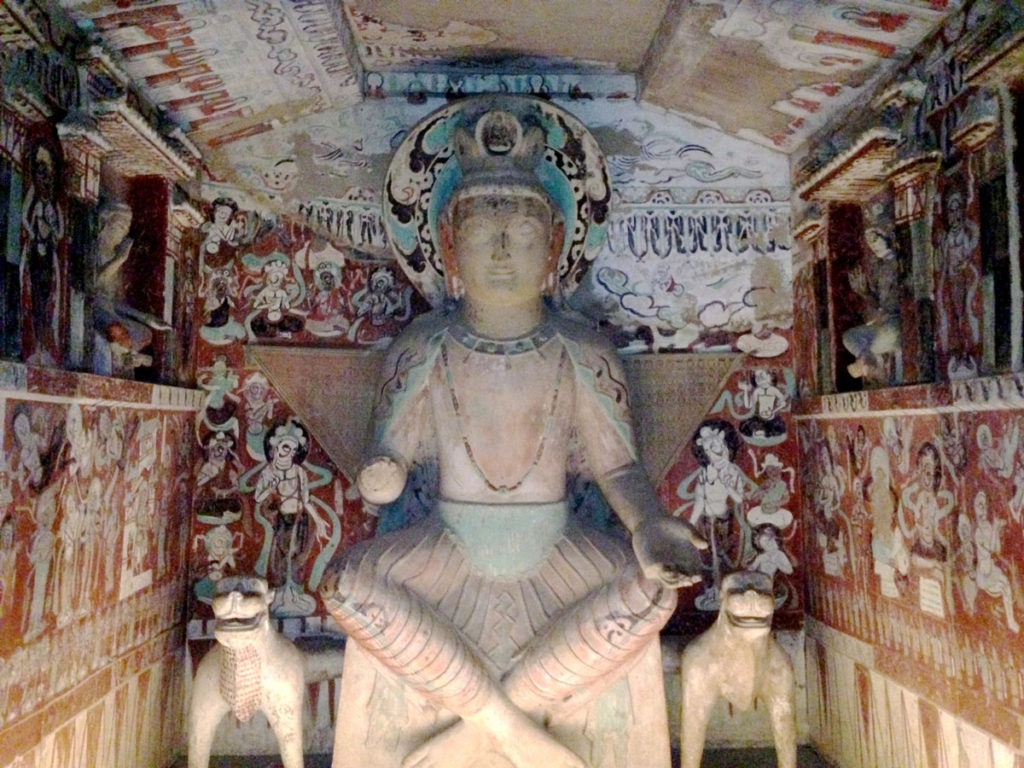As part of an ongoing cultural exchange with the National Academy of Chinese Painting, I experienced the Mogao Caves.
My travels took place with a group of artists and business leaders, including fellow American artists Zoë Charlton, Jane Dickson (NA 2014), Peter Drake, Wendy V. Edwards, David Frazer, Jerry Mischak, and Tony Shore; and artist members of the Chinese National Academy of Painting including Xiaoyang Yang (President of the National Academy of Chinese Painting), Luang Yu (Director of Culture and Art of Shenzhen), Nun Niu (Chinese Oil Society), Zhongjie Yin (Director of the Northwest Collection Museum), and Yong Zhou, Zheng Lu, and Michael Yuan Wang.
Located on the fabled Silk Road in the city of Dunhuang in the northwestern Chinese province of Gansu, and sometimes referred to as The Caves of a Thousand Buddhas, there are 1,000 years of wall paintings and sculpture found throughout almost 500 caves.

The experience provided me with a very visceral understanding of shifting scale hierarchies and my place as an observer within this spiritual order. For this writing, I am sharing my impressions and thoughts from three of the caves.
Cave 427
In one cave, we were greeted with ghost fighters, king-like muscle men whose job is to stomp on the heads of demons. Their presence was monumental, as their heads and auras nearly grazed the roof of the cave. The entrance to this cave also held a bell and drum to ring at sunrise and beat at night.

Once inside, past the ghost fighters, there was a stupa-like architectural setting for the central Buddha and his sidekicks, who were very goofy and planted to the left and right of him. The stone-carved sculptures were layered with mud and paint to detail the faces of divine beings, as well as comical, almost cartoon-like characters and donors with twisted faces and gripping feet.
As we continued walking (thank you, Peter and Janice Drake, for the LED flashlight), I noted the layers of gold piping that lined the walls sparkled and shimmered in the light. I was then greeted by a landscape of what appeared to be paradise: a nature scene of colorful renderings of lush clouds, trees, water, birds, angels, oxen, and gods. There were, surprisingly, many blank rectangles which appeared faded but still present throughout the landscape. They were later confirmed to be descriptions of the scenes and episodes of wonderment which had worn off over the years.

Surprisingly, they gave the experience an almost Modernist/Cubist feel and provided a unique juxtaposition to the lyrical rendering of the more natural and flowing paradise scene.
Cave 429
In another cave, there was a truncated ceiling which mimicked Chinese architecture. It was covered with 1,000 hand-painted Buddhas climbing all the way down the walls, giving it a wallpaper-like effect and feel to which I exclaimed, “Who wouldn’t want Buddha wallpaper?” However, upon closer inspection, each Buddha was unique with its own structure and hand-painted idiosyncrasies.
Cave 96
This cave was an extraordinary nine-flight temple which was so big that you became positioned between the (standing) Buddha’s feet. As you look up past his knees, chest, and face towering nine stories above you, you feel as small as a cat. I felt compelled to pray and thank the Buddha simply for not stepping on me.

The entrance to Cave 96, photo by Roberto Juarez 
9-story Buddha, photo by Roberto Juarez
In one painting, I noticed a row of women in burqas, which actually turned out to be sand dunes in the Gobi desert rendered in a stylized way.

Only later, when I returned to the hotel, did I notice and appreciate a similar shadow play on the sand dunes just outside my window.

Roberto Juarez (NA 2011) is a visual artist who has been active in the area of painting, drawing, and large-scale public commissions throughout his career. Born in Chicago, he received artistic training at the San Francisco Art Institute and UCLA. He has lived and worked in New York City since 1981. From 1981 to 2000 Juarez regularly showed at New York’s Robert Miller Gallery. Since then, he has had solo and group shows at museums and galleries in the United States, Latin America, Europe, and China. His many awards include a Guggenheim Fellowship in Painting and the Rome Prize from the American Academy in Rome.

